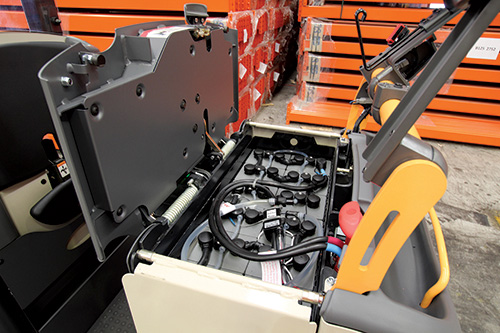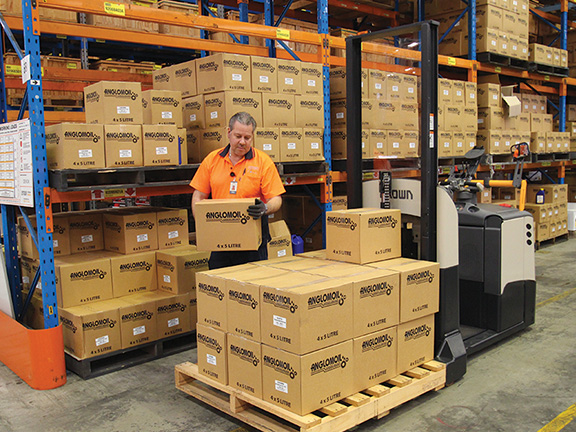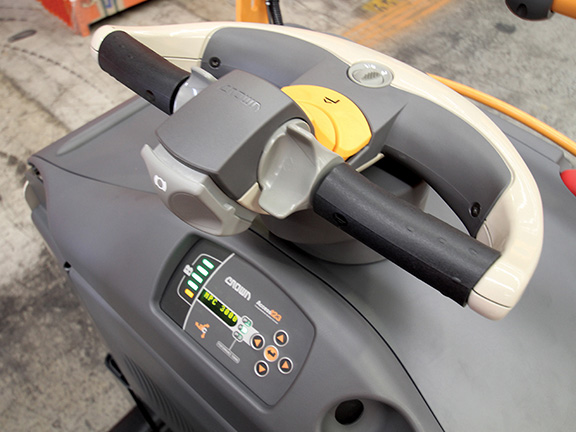The Crown MPC 3000 Series of forklifts turn design on its head, delivering a truly multi-purpose series of trucks specifically suited to order picking.
UP UNTIL this truck, I’d never before tested a Crown forklift product before. And for weeks in the lead-up, the old jingle “There is nothin’ like a Crown for pickin’ it up and puttin’ it down” kept running through my head.
The forklift review day was even more exciting as I was not prepared for the design of truck presented to my long-time photographer/videographer buddy Barry Ashenhurst and me.
Here was a forklift truck that had the steering wheel and controls at what is normally the rear of a truck, and the mast and fork tynes at what is normally the front. The design is like driving a side-by-side ATV with a tray on the back.
This truck is designed specifically for order picking, where the ground level pallet is picked first and, when empty, the replacement pallet above this is brought down to re-fill the pick station.
The model I tested had a non-telescopic mast, but still achieved a lift height of 1780mm with a maximum load of 1200kg – not bad for a truck that weighs less than 1920kg complete with battery.
 |
|
The Crown MPC 3000 forklift has the steering wheel and controls at what is normally the rear of a truck, and the mast and fork tynes at what is normally the front.
|
CROWN MPC 3000 FORKLIFT
Despite its tiny size, the MPC 3000 is packed with clever features. Stepping up to the cushioned non-skid floor that has a pressure sensor for safety, there’s plenty of space for a fold-out and height-adjustable seat – the ideal location for sitting while reflecting on the Crown jingle.
On the half-circle steering wheel (obviously designed for operators having massive overhanging bellies like mine) there are thumb controls for forward and reverse with a thumb-operated brake in the middle.
Ahead of the direction controls, designed for either right or left-handed operators are thumb-operated fork raise and lower switches. A horn switch is fitted in each of the wheel grips that connect the half circle.
- Watch the video: Crown MPC3000 forklift
A compact dashboard in the steering wheel column has a battery charge indicator and keypad start-up of machine once a four-digit code has been entered. An individual code can be provided for each operator, preventing hooning by unauthorised operators.
The machine is set up so once the battery charge drops to 20 per cent, for example, only the traction and power steering motors function to enable the truck to be returned to its charging point.
Two maximum travel speeds are available for either novice or experienced operators, set by a little switch ahead of the main fork lift/lower switches, which incidentally are yellow to separate them from the grey direction switches.
Forward of the wheel is a solid bar to attach a clipboard, rear-vision mirror and provision for attaching a plug to run Crown’s operator and lift truck management system Infolink. Anything mounted on this bar can be quickly tightened or removed using Allen keys.
And ahead of this bar is a deep recess with handle for carrying shrink wrap or other materials.
Turning to what is normally the front of a truck is the mast, lift chain and fork tynes separated from the operator by a full-height, thick perspex screen. On the demo there was no need for an overhead guard because the forks can’t be lifted above mast height.
Grab holds are provided either side of the screen mounting with deep document/drink bins. Other useful touches are fork raise/lower switches either side that enable an operator to raise or lower a load without standing in the truck.
The tynes don’t drop all the way down, preventing them dropping to the normal 50mm height off ground when the operator is on board and potentially crushing the steel caps of a careless operator. This device activates immediately when the operator steps down from the cushioned floor.
Two hinged clips access the large-capacity battery pack. There’s a single fill point for the cells and Crown recommends using only de-mineralised water in these. Crown even supplies a battery care manual. A smart charger option is available where the battery can be charged during breaks to maintain a longer run time.
Removing another couple of screws accesses the nerve centre of this truck. Taking pride in the centre is the vertically-mounted AC traction motor, flanked to its right by the power steering motor. To the right of this is the control hub that connects to the steering wheel and other thumb switches via a CAN controller.
The hydraulic lift/lower motor and hydraulic fluid tank are mounted to the left of the drive motor with a full wiring schematic above the traction motor. This is simply the best motor access I’ve ever seen on a battery forklift.
 |
|
A smart charger option is available where the battery can be charged during breaks to maintain a longer run time.
|
DRIVE TIME
Wow, was I itching to put this truck through its paces!
Crown’s Nigel Tunnell-Jones allowed me plenty of warehouse floor space to get the demo truck to full speed. Running out to 12.5km/h unladen using the ‘rabbit’ or ‘hare’ mode might not seem fast but was quick enough to feel the wind in my hair (maybe it was just a draft in the warehouse).
First impressions were how much space there was in the foot-well space. I could easily turn to the front or back without my belly getting stuck in the opening between the battery enclosure and screen mounting base.
After the fire-up code was entered and battery checked for sufficient charge (we hadn’t even used 20 per cent after several hours of testing) I set the travel control for ‘tortoise’ and gingerly pressed the thumb control forward.
With typical AC control precision I could inch slowly forward until getting the hang of handling the truck.
Once I had the hang of the thumb direction control I could switch to ‘hare’ control, which still gave me the precise control off the mark, just a faster travel speed with a similar traction motor whine to that experienced in Sydney’s current electric trains.
One thing I did notice was that despite the relatively skinny traction wheel, the truck was not at all skittish at maximum travel speed.
The power steering had good feel, but I did find that negotiating tight corners meant I had to swing wide to prevent the fork tynes clobbering objects. Again, driving this truck is more like a car or ATV instead of a conventional forklift, where steering is at the back of the truck.
I soon developed a technique of coming to a stop using the thumb-operated brake on the steering wheel column, even though when I released the power control, Crown’s eGen braking system that uses the traction motor for braking stopped the truck fairly quickly.
Now for the acid test (well, I don’t want to make a fool of myself in the presence of expert operators).
Nigel set up a test in Crown’s Smithfield NSW training facility, where I’d retrieve a one-tonne pallet and take it to a road truck tray, then back again. With the truck’s tight turning circle I was able to back up to the stack, then, looking through the screen, clearly see where the tynes were in relation to the pallet. The AC controls gave me precise tyne positioning with excellent inching. I slid the tynes in, applied slight raise pressure to lift the pallet clear of the stack, retrieved the load, and moved forward sufficiently to lower the pallet to just above floor level.
At all times, the truck was completely stable even with the pallet raised to almost full lift height. A quick about face and I could back the pallet up to the tray, lift the pallet up and back it onto the tray. Then a complete reversal to return the pallet back to its original stacking position.
With a little practice, the whole procedure could be done very quickly, such was the control AC drive system provided.
THE BOTTOM LINE
The MPC 3000 Series is available in non-telescopic or telescopic mast configurations up to a lift height of 4,300mm, the latter having a full guard over the operator.
But, whichever truck is chosen, all have excellent build quality and finish that will easily stand up to daily operation where operators may be less gentle than me. And, unusually, they’re designed for right- or left-handed operation.
For a stand-up truck, the ergonomics are excellent and indicative of Crown’s long experience in designing and manufacturing battery-powered forklifts. Just remember: as the Series are ride-on trucks and lift more than 900mm, a LF licence is required to operate them.
Crown has designed and developed a truly multi-purpose series of trucks that should provide a fast ROI.
Photography: Barry Ashenhurst



